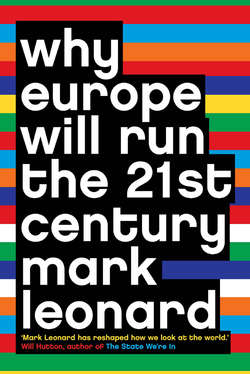Читать книгу Why Europe Will Run the 21st Century - Mark Leonard - Страница 9
Network Europe
ОглавлениеAlthough he predated Dee Hock and came from a very different world, the principles that Monnet promoted bear a remarkable resemblance to those that have turned Visa into one of the most successful companies in global history. Though very few people realize it, the European Union he gave birth to is already closer to Visa than it is to a state: it is a decentralised network that is owned by its member-states.3
The headquarters of the EU Council says it all. The Justus Lipsius Building looks like it has landed in Brussels from outer-space – obliterating the genteel Art-Deco surroundings with its marble footprint. Clad in heavy grey stone and reflective glass, this anonymous rectangular building covers some 215,000 square metres, circling a mammoth atrium with 24 kilometres-worth of corridors of power.4 Like a Russian doll, the external shell has replicated itself infinitely inside, housing dozens of rectangular rooms – each containing a rectangular table with a hole in the middle. The tables are neatly set up for European negotiations with placenames for the twenty-five member-states, long, thin microphones, notepads, and bunches of red pencils. In some of the rooms there are booths for interpreters to translate between the twenty EU languages. This building is like a factory for European agreements. And because the EU is a network rather than a state, negotiation is not a part-time activity: it goes on every single day, around the clock. Like the banks that own and control Visa, it is the national governments that set the agenda for the future of Europe.
Four times a year, all the EU Heads of Government gather here amid a fanfare of publicity, with a media party that runs to the thousands. There are between 80 and 90 meetings a year5 of various formations of the Council of Ministers, which brings national ministers (agriculture ministers, finance ministers, health ministers, etc) together to agree policies in each of their areas. Working under the ministers are groups of national civil servants. The ‘Committee of Permanent Representatives’, made up of ambassadors from all the member-states, is responsible for agreeing 90 per cent of the European Union’s legislation.6 Working under it are dozens of ‘working groups’ that prepare agreements in each of the different policy areas.
The process is complicated, but it allows every country or parliament in the network to have some say. Before decisions even reach the magic circle in Brussels, national parliaments can mandate their governments to stick to a clear national position. After decisions have been taken, they then face a tough process of scrutiny from the 723 directly elected members of the European Parliament who represent citizens from the twenty-five member-states.7 Finally, the laws that are agreed are upheld by the European Court of Justice, made up of judges appointed from all the member-states and which acts as a supreme court.
In seminar rooms across the world, historians and political scientists are trying to understand and categorize the European Union. The usual parlour game is to guess which country the EU will end up copying. Will it be the USA – perhaps the 1850s confederal model? Or will it be a constitutional federal democracy like post-war Germany, or the Swiss system where national political debates are much less important than local scuffles and the needs of the secretive banking economy? Some predict an overpowering bureaucratic state on the Napoleonic model, while others fear we will build a political system so divided that it could collapse like the French Fourth Republic. Some Americans, in particular, are impatient for the Union to unite; to develop a federal structure; to have a constitution that clearly separates the executive, judiciary, and legislature; to elect a single president; and to give the European Parliament law-making powers like national parliaments. In short, to get a ‘single phone number’.8 But Jean Monnet’s genius was to create a political structure that is quite different from the traditional nation-state.
Although some federalists still dream of a country called Europe, and the European Union sometimes pretends to be a state with its flag, passport, and anthem, it is fundamentally different from a state. Like Visa, it is a decentralized network that exists to serve its member-states. The EU is a skeletal organization that leaves the real power to its member-states, which are responsible for implementing and overseeing the vast majority of the European Union’s activities. This revolutionary structure has allowed the European Union to grow with the support of its members. But it has also fundamentally changed the nature of global politics.
